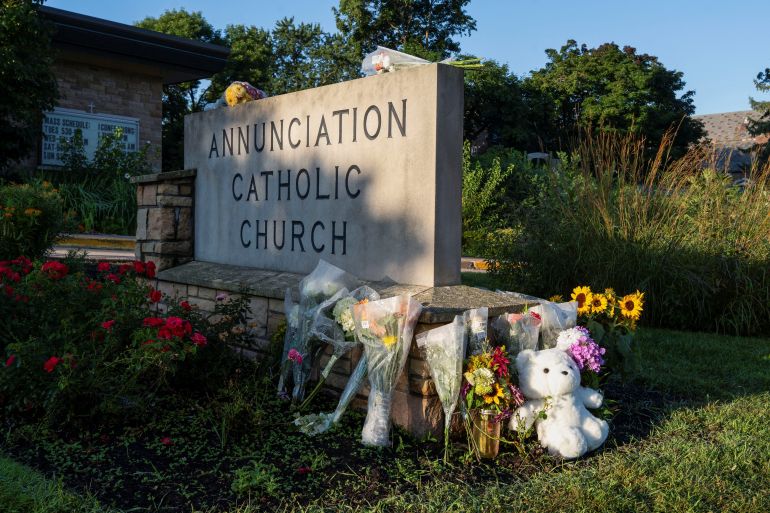Fact check: Have mass shootings decreased in the US since 2022 law?
Then-President Biden signed 2022 gun violence legislation aiming for reform, but its effect remains unclear.

By Amy Sherman | Politifact
Published On 29 Aug 202529 Aug 2025
Senator Chris Murphy, a leading supporter of stricter gun laws, said hours after an August 27 deadly Minneapolis school shooting that legislation enacted during the Biden administration led to a decline in mass shootings.
“There is something deeply wrong with a country that chooses to make running for their lives part of kids’ back to school ritual,” Murphy wrote on X. “When we finally passed a gun safety bill in 2022, mass shooting began to drop. But it was an unacceptably small start. We must do more.”
Recommended Stories
list of 4 itemsend of list
Murphy referred to the Bipartisan Safer Communities Act that then-President Joe Biden signed into law in June 2022 after mass shootings in Buffalo, New York and a Uvalde, Texas elementary school. The legislation combined gun safety provisions with mental health and school security resources and marked the first congressional gun control measure in nearly three decades.
In Minneapolis, Robin Westman fired through the windows of the Church of the Annunciation during a morning mass to mark the beginning of the school year, killing two children and injuring 18 other people. Westman, 23, died from a self-inflicted gunshot wound.
Murphy’s spokesperson said the senator referred to the number of mass shootings as measured by the Gun Violence Archive, an online database that showed a decrease in mass shootings in 2024 compared with 2023. However, assessing whether the 2022 law caused the decrease is difficult to determine. Experts said the law might have played a role, but they are unaware of academic research addressing that question.
Advertisement
“This is not to say that it may not have any impact – it’s virtually impossible to demonstrate any direct causality, but it’s important to keep in mind many other potential correlates of that drop, including, for example, an overall drop in crime, return to prevention and intervention strategies and so forth,” said Alex R Piquero, a University of Miami professor of criminology and former director of the Bureau of Justice Statistics.
No official definition of mass shootings
There is no widely agreed upon definition for mass shootings. Different groups measure mass shootings in varying ways based on the number of people injured or killed. Some exclude gang violence or domestic violence from their counts and include only indiscriminate violence, when a shooter fires a gun at random in public. This means that mass shooting numbers can vary significantly depending on the metrics – showing anywhere from dozens or fewer incidents to hundreds in a given year.
The Gun Violence Archive defines mass shootings as events in which at least four people are injured or killed, excluding the shooter. As of August 27, the archive found 642 mass shootings in 2022, 660 mass shootings in 2023, 503 in 2024 and 286 year-to-date in 2025.
Some other mass shooting trackers also show a decline from 2023 to 2024, although they have narrower methodologies that result in smaller raw numbers.
Mass shootings have decreased but law’s impact is unclear
Gun violence experts expressed caution about attributing the decline in mass shootings to the 2022 law for several reasons:
The 2022 law had many components. It’s difficult to attribute the decrease to the law because the law “had so many different parts”, including money to support state-level “red flag” laws, said Jaclyn Schildkraut, executive director of the Regional Gun Violence Research Consortium at the Rockefeller Institute of Government. Red flag laws allow courts to temporarily remove a person’s firearms if the person poses a danger to other people.
Proving a connection would involve analysing changes collectively and over different initiatives over a much longer period of time, Schildkraut said.
Mass shootings are rare. Because they are statistically very rare, “it is hard to distinguish change due to something like the Bipartisan Safer Communities Act from random variation over time,” said Veronica Pear, assistant professor at the Centers for Violence Prevention at University of California, Davis.
Terry Schell, a senior behavioural scientist who studies firearms and violence at Rand Corporation, a nonpartisan think tank, said: “It is exceptionally difficult to determine, empirically, if any national law caused a particular shift in a rare outcome. Even if the mass shooting rate dropped to zero in the years following passage, all that would tell us is that SOMETHING happened in 2023 to reduce mass shootings. It could be this law; it could be something totally different.”
Advertisement
Schell said to make claims about causation requires data that allows researchers to rule out alternative causes.
Our ruling
Murphy said, “When we finally passed a gun safety bill in 2022, mass shooting began to drop.”
He pointed to Gun Violence Archive data showing 503 mass shootings in 2024, a decline from 660 in 2023. Midway through 2022, Biden signed the Bipartisan Safer Communities Act into law.
Gun violence experts said they are unaware of research showing the impact of the law on mass shooting numbers. They cautioned that the law had many components and assessing its impact on mass shootings is difficult.
The statement is partially accurate but leaves out important details. We rate it Half True.
Researcher Caryn Baird contributed to this fact check.
